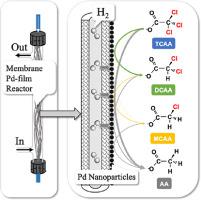Water Research ( IF 11.4 ) Pub Date : 2021-01-15 , DOI: 10.1016/j.watres.2021.116841 Yuhang Cai 1 , Xiangxing Long 2 , Yi-Hao Luo 3 , Chen Zhou 3 , Bruce E Rittmann 3

|
Trichloroacetic acid (TCAA) is a common disinfection byproduct (DBP) produced during chlorine disinfection. With the outbreak of the Coronavirus Disease 2019 (COVID-19) pandemic, the use of chlorine disinfection has increased, raising the already substantial risks of DBP exposure. While a number of methods are able to remove TCAA, their application for continuous treatment is limited due to their complexity and expensive or hazardous inputs. We investigated a novel system that employs palladium (Pd0) nanoparticles (PdNPs) for catalytic reductive dechlorination of TCAA. H2 was delivered directly to PdNPs in situ coated on the surface of bubble-free hollow-fiber gas-transfer membranes. The H2-based membrane Pd film reactor (H2−MPfR) achieved a high catalyst-specific TCAA reduction rate, 32 L/g-Pd/min, a value similar to the rate of using homogeneously suspended PdNP, but orders of magnitude higher than with other immobilized PdNP systems. In batch tests, over 99% removal of 1 mM TCAA was achieved in 180 min with strong product selectivity (≥ 93%) to acetic acid. During 50 days of continuous operation, over 99% of 1 mg/L influent TCAA was removed, again with acetic acid as the major product (≥ 94%). We identified the reaction pathways and their kinetics for TCAA reductive dechlorination with PdNPs using direct delivery of H2. Sustained continuous TCAA removal, high selectivity to acetic acid, and minimal loss of PdNPs support that the H2−MPfR is a promising catalytic reactor to remove chlorinated DBPs in practice.
中文翻译:

沉积在 H2 转移膜上的钯纳米粒子催化三氯乙酸 (TCAA) 稳定脱氯成乙酸
三氯乙酸 (TCAA) 是氯消毒过程中常见的消毒副产物 (DBP)。随着 2019 年冠状病毒病 (COVID-19) 大流行的爆发,氯消毒的使用有所增加,增加了本已相当大的 DBP 暴露风险。虽然许多方法能够去除 TCAA,但由于其复杂性和昂贵或危险的投入,它们在连续处理方面的应用受到限制。我们研究了一种使用钯 (Pd 0 ) 纳米粒子 (PdNPs) 进行 TCAA 催化还原脱氯的新型系统。H 2被直接输送到原位涂覆在无气泡中空纤维气体传输膜表面的 PdNPs 上。H 2基膜钯膜反应器(H 2−MPfR) 实现了高催化剂特异性 TCAA 还原率,32 L/g-Pd/min,该值类似于使用均匀悬浮的 PdNP 的速率,但比其他固定化 PdNP 系统高几个数量级。在批量测试中,1 mM TCAA 在 180 分钟内去除率超过 99%,对乙酸的产品选择性很强 (≥ 93%)。在连续运行 50 天的过程中,超过 99% 的 1 mg/L 进水 TCAA 被去除,再次以乙酸作为主要产物 (≥ 94%)。我们确定了使用直接输送 H 2使用 PdNP 进行 TCAA 还原脱氯的反应途径及其动力学。持续的 TCAA 去除、对乙酸的高选择性和 PdNP 的最小损失支持 H 2−MPfR 是一种很有前途的催化反应器,可在实践中去除氯化 DBP。










































 京公网安备 11010802027423号
京公网安备 11010802027423号